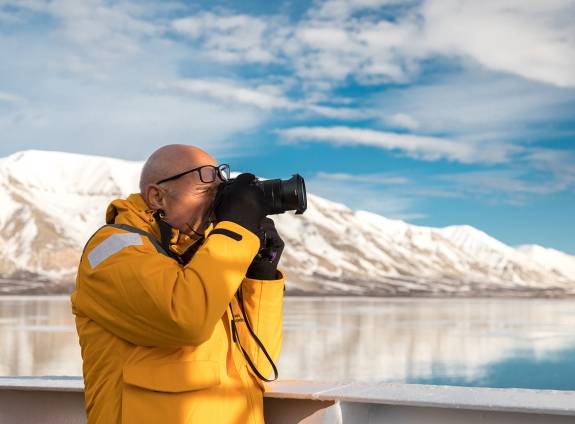You’re almost ready to depart on your highly anticipated polar adventure. Plane tickets are booked. Your cabin awaits. Your bags are packed. All you need to do now is double-check you’ve got the right cameras, lens and other photographic gear for your dream expedition.
The essential photography gear to pack:
1. 1-2 cameras: Your camera of choice could be a DSLR, point-and-shoot, or a cell phone. We’ve geared our packing list for DSLRs. (If you’re shooting manually, keep your shutter speed high when on a moving ship or Zodiac). If you opt for a smart phone, we recommend at least an iPhone 6 or comparable smart phone, preferably waterproof or with a waterproof case. Having at least two devices to take photos will ensure you won’t miss a moment in case one camera fails at an inopportune time.
2. General purpose lens: If you only bring one lens, opt for a 24-105mm or 24-70mm zoom lens which allow you to shoot in a variety of modes —from portraits to landscapes—without switching lens.
3. Large plastic resealable bag: Moving from a cold to warm environment, or vice versa, leaves your camera susceptible to condensation build-up. Before Zodiac cruising, pack your camera in a sealed plastic bag and store it your dry sack. (Note: after your off-ship excursion, seal your camera in the resealable bag again –without any air in the bag – and put it back in your dry sack. Upon returning to your room, let your camera warm up to room temperature before using it again.)
4. Dry bag: A must-have to keep your camera gear dry – especially when cruising on Zodiacs.
5. Microfiber lens cloths and/or pen: A lens cloth is essential, especially in polar environments. Because these will likely get wet, it’s good to bring a few. Lens pens are also beneficial as they can help you quickly clean water spots off your lens on a moving Zodiac.
6. Rain sleeves: Rain sleeves keep your camera and lens safe from rain, snow, and water splashes while shooting.
7. Extra batteries: Batteries lose power quickly in cold environments. It’s always best to have extra batteries charged and keep them warm in the inside pocket of your Quark Expeditions® parka.
8. Power converters: Make sure you can charge everything you need – or bring a power bar to plug into your converter.
9. Small laptop and external hard drives: Bring a laptop so you can offload your photos from your camera. We recommend backing up your photos in at least 2 locations, i.e., external hard drives. The last thing you want is to lose the photos from your trip of a lifetime.
10. Card reader: Make sure you have a card reader to offload your photos from your camera to your laptop.
Recommended gear if you want to bump up your photos a notch:
11. Wide angle lens: Bringing a 14-24mm or 17-35mm lens is great for capturing the vast landscapes of the polar regions. You really can’t capture the vastness of these regions without it.
12. Telephoto lens: A 70-200mm lens is a great telephoto lens for Antarctic wildlife close-ups since the wildlife is closer than in the Arctic. If you’re photographing polar bears or other far-away wildlife in the Arctic, we recommend a 100-400mm or 200-600mm lens. Alternatively, you could use a 70-200mm or 70-300mm lens with a lens extender, which increases the focal length of your lens. While prime lenses provide excellent image quality, they may not have the versatility necessary to capture the polar regions.
13. Polarized lens filters: These are a nice touch to combat bright sunlight, bring out the colour saturation in your photos, and protect your lens from scratches. Make sure you have filters that fit your lenses.
14. Neutral Density (ND) lens filters: These help reduce the amount of light entering the lens, which allows more flexibility in selecting aperture and shutter speed that would otherwise produce overexposed photos.
15. Large plastic resealable bag: Moving from a cold to warm environment, or vice versa, leaves your camera susceptible to condensation build-up. Before Zodiac cruising, pack your camera in a sealed plastic bag and store it your dry sack. Upon arriving back from your off-ship excursion, you can seal your camera in the resealable bag again – without any air in the bag – and put it back in your dry sack. Upon returning to your room, take out your camera in your suite to warm up to room temperature before using it again.
16. Extra memory cards: Packing extra memory cards allow you to offload your photos frequently.
17. Tripod: You can likely leave your tripod at home unless you plan on shooting video or capturing photos with long exposures, like the Northern Lights.
Editor’s note: Please keep in mind that charter flights to your point of embarkation have limited luggage capacity. Approximately one month prior to your departure, you will receive your Final Documents via email confirming all the details about your trip, including weight restrictions.
